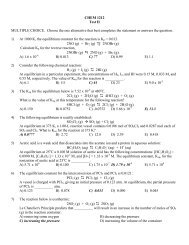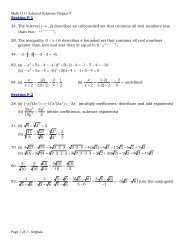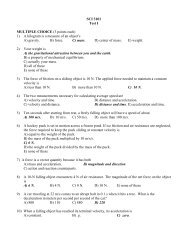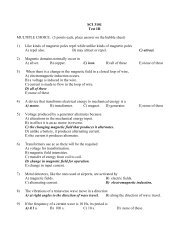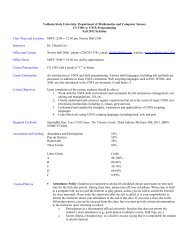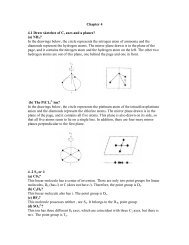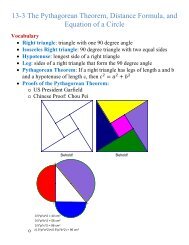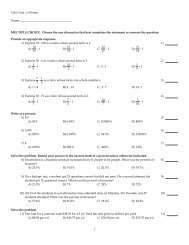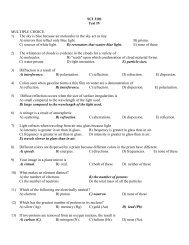CHEM 1211K Test II MULTIPLE CHOICE. (3 points each) 1) The ...
CHEM 1211K Test II MULTIPLE CHOICE. (3 points each) 1) The ...
CHEM 1211K Test II MULTIPLE CHOICE. (3 points each) 1) The ...
Create successful ePaper yourself
Turn your PDF publications into a flip-book with our unique Google optimized e-Paper software.
<strong>CHEM</strong> <strong>1211K</strong><br />
<strong>Test</strong> <strong>II</strong><br />
<strong>MULTIPLE</strong> <strong>CHOICE</strong>. (3 <strong>points</strong> <strong>each</strong>)<br />
1) <strong>The</strong> charge on the manganese in the salt MnF 3 is __________.<br />
A) +1 B) +2 C) -2 D) +3 E) -1<br />
2) Which formula/name pair is incorrect<br />
A) FeS iron(<strong>II</strong>) sulfide B) FeSO 4 iron(<strong>II</strong>) sulfate<br />
C) FeSO 3 iron(<strong>II</strong>) sulfite D) Fe 2 (SO 3 ) 3 iron(<strong>II</strong>I) sulfite<br />
E) Fe 2 (SO 4 ) 3 iron(<strong>II</strong>I) sulfide<br />
3) <strong>The</strong> name of PCl 3 is __________.<br />
A) monophosphorous trichloride B) phosphorus trichloride<br />
C) trichloro potassium D) phosphorous(<strong>II</strong>I) chloride<br />
E) potassium chloride<br />
4) Which one of the following is the formula of perchloric acid<br />
A) HClO B) HClO 4 C) HClO 3 D) HCl E) HClO 2<br />
5) When the following equation is balanced, the coefficient of water is __________.<br />
N 2 O 5 (g) + H 2 O (l) HNO 3 (aq)<br />
A) 3 B) 2 C) 1 D) 4 E) 5<br />
6) Of the reactions below, which one is a decomposition reaction<br />
A) 2CH 4 + 4O 2 2CO 2 + 4H 2 O B) NH 4 Cl NH 3 + HCl<br />
C) 2N 2 + 3H 2 2NH 3 D) Cd(NO 3 ) 2 + Na 2 S CdS + 2NaNO 3<br />
E) 2Mg + O 2 2MgO<br />
7) <strong>The</strong> formula weight of ammonium sulfate ((NH 4 ) 2 SO 4 is __________ amu.<br />
A) 132 B) 116 C) 118 D) 100 E) 264<br />
8) <strong>The</strong> mass % of Al in aluminum sulfate, Al 2 (SO 4 ) 3 , is __________.<br />
A) 15.77 B) 35.94 C) 45.70 D) 7.886 E) 21.93<br />
9) How many moles of carbon dioxide are there in 52.06 g of carbon dioxide<br />
A) 3.134 x 10 25 B) 0.8452 C) 1.183 D) 8.648 x 10 23 E) 6.022 x 10 23<br />
10) A sulfur oxide is 50.0% by mass sulfur. This molecular formula could be __________.<br />
A) SO 3 B) SO 2 C) SO D) S 2 O E) none of these
11) <strong>The</strong> combustion of propane (C 3 H 8 ) in the presence of excess oxygen yields CO 2 and H 2 O:<br />
C 3 H 8 (g) + 5O 2 (g) 3CO 2 (g) + 4H 2 O (g)<br />
when 2.5 mol of O 2 are consumed in their reaction, __________ mol of CO 2 are produced.<br />
A) 3.0 B) 2.5 C) 5.0 D) 6.0 E) 1.5<br />
12) Pentacarbonyliron (Fe(CO) 5 ) reacts with phosphorous trifluoride (PF 3 ) and hydrogen, releasing carbon<br />
monoxide:<br />
Fe(CO) 5 + 2PF 3 + H 2 Fe(CO) 2 (PF 3 ) 2 (H) 2 + 3CO<br />
<strong>The</strong> reaction of 5.0 mol of Fe(CO) 5 , 8.0 mol of PF 3 and 6.0 mol of H 2 will release __________ mol of CO.<br />
A) 5.0 B) 24 C) 15 D) 12 E) 6.0<br />
13) Solid aluminum and gaseous oxygen react in a combination reaction to produce aluminum oxide:<br />
4Al (s) + 3O 2 (g) 2Al 2 O 3 (s)<br />
In a particular experiment, the reaction of 2.5 g of Al with 2.5 g of O 2 produced 3.5 g of Al 2 O 3 . <strong>The</strong> %<br />
yield of the reaction is __________.<br />
A) 37 B) 26 C) 74 D) 47 E) 66<br />
14) <strong>The</strong> net ionic equation for the reaction between aqueous solutions of HCl and KOH is __________.<br />
A) HF + KOH H 2 O + K + + F -<br />
B) HF + OH - H 2 O + F -<br />
C) H + + F - + K + + OH - H 2 O + K + + F -<br />
D) H + + OH - H 2 O<br />
E) HF + K + + OH - H 2 O + KF<br />
15) Which one of the following compounds is insoluble in water<br />
A) FeCl 3 B) ZnS C) K 2 O D) AgNO 3 E) NaCl<br />
16) Which one of the following is a weak acid<br />
A) HClO 4 B) HCl C) HNO 3 D) HI E) HF<br />
17) Oxidation is the __________ and reduction is the __________.<br />
A) loss of oxygen, gain of electrons B) gain of oxygen, loss of electrons<br />
C) loss of electrons, gain of electrons D) gain of electrons, loss of electrons<br />
E) gain of oxygen, loss of mass<br />
18) What is the concentration (M) of CH 3 OH in a solution prepared by dissolving 11.7 g of CH 3 OH in<br />
sufficient water to give 230 mL of solution<br />
A) 1.59 x 10 -3 B) 11.9 C) 0.0841 D) 11.9 x 10 -3 E) 1.59<br />
19) What volume (L) of 0.250 M HNO 3 is required to neutralize a solution prepared by dissolving 17.5 g of<br />
NaOH in 350 mL of water<br />
A) 1.75 B) 50.0 C) 1.75 x 10 -3 D) 0.44 E) 0.070
20) Which one of the following statements is false<br />
A) <strong>The</strong> actual numerical value of E can be measured.<br />
B) ∆E = E final - E initial<br />
C) E is a state function.<br />
D) ∆E = q + w<br />
E) When a system undergoes a process in which it gains energy from the surroundings, the ∆E for the<br />
process is positive.<br />
21) Of the following, which one is a state function<br />
A) q B) w C) heat D) H E) none of the above<br />
22) For a given process at constant pressure, ∆H is negative. This means that the process is _______.<br />
A) a state function B) endothermic C) exothermic D) equithermic E) energy<br />
23) <strong>The</strong> value of ∆H o for the reaction below is -336 kJ. Calculate the heat (kJ) released to the surroundings<br />
when 23.0 g of HCl is formed.<br />
CH 4 (g) + 3Cl 2 (g) CHCl 3 (l) + 3HCl (g)<br />
A) -2.57 x 10 3 B) -70.7 C) -336 D) -211 E) -177<br />
24) <strong>The</strong> enthalpy change for the following reaction is -486.3 kJ:<br />
2H 2 (g) + O 2 (g) 2H 2 O (g)<br />
<strong>The</strong>refore, the enthalpy change for the reaction listed below is ________ kJ:<br />
4H 2 O (g) 4H 2 (g) + 2O 2 (g)<br />
A) -483.6 B) 483.6 C) 967.2 D) -483.6 E) 2.34 x 10 5<br />
25) A chemical reaction that absorbs heat from the surroundings is said to be __________ and has a<br />
__________ ∆H at constant pressure.<br />
A) endothermic, positive B) endothermic, negative<br />
C) exothermic, negative D) exothermic, positive<br />
E) exothermic, neutral
(5 <strong>points</strong>) At one time, a common means of forming small quantities of oxygen gas in a laboratory was to<br />
heat KClO 3 :<br />
2 KClO 3 (s) 2 KCl(s) + 3 O 2 (g) ∆H = -89.4kJ<br />
For this reaction, calculate ∆H for the formation of 3.51mol of O 2<br />
−89.4kJ<br />
x<br />
=<br />
3O<br />
2<br />
3.51mol<br />
x = 104.6kJ<br />
= 105kJ<br />
(10 <strong>points</strong>) Some sulfuric acid is spilled on a lab bench. It can be neutralized by sprinkling sodium bicarbonate<br />
(NaHCO 3 ) on it and then mopping up the resultant solution. <strong>The</strong> sodium bicarbonate reacts with<br />
sulfuric acid as follows:<br />
2 NaHCO 3 (s) + H 2 SO 4 (aq) Na 2 SO 4 (aq) + 2 H 2 O(l) + 2 CO 2 (g)<br />
Sodium bicarbonate is added until the fizzing due to the formation of CO 2 (g) stops. If 27mL of<br />
6.0M H 2 SO 4 was spilled, what is the minimum mass of NaHCO 3 that must be added to the spill to<br />
neutralize the acid<br />
moles H<br />
2<br />
SO<br />
4<br />
= 6.0M<br />
(0.027L<br />
_<br />
= 0.162 mol H<br />
2<br />
SO<br />
4<br />
2 NaHCO<br />
1H<br />
2<br />
SO<br />
4<br />
3<br />
=<br />
x<br />
0.162mol<br />
H<br />
2<br />
x = 0.324 mol<br />
SO<br />
4<br />
NaHCO<br />
3<br />
gNaHCO<br />
3<br />
= 0.324mol<br />
= 27g<br />
( 84.0g<br />
/ mol)
(10 <strong>points</strong>) Lithium and nitrogen react to produce lithium nitride:<br />
6 Li(s) + N 2 (g) 2 Li 3 N(s)<br />
If 5.00g of <strong>each</strong> reactant are allowed to react, how many grams of Li 3 N are formed<br />
5.0g<br />
Moles Li =<br />
6.941g<br />
/ mol<br />
= 0.720mol<br />
Moles N<br />
2<br />
5.0g<br />
=<br />
28g<br />
/ mol<br />
= 0.179mol<br />
Limiting Reagent<br />
0.720mol<br />
Li=<br />
= 0.120<br />
6<br />
0.179mol<br />
N<br />
2<br />
= = 0.179<br />
1<br />
Limiting Reagentis Li<br />
2Li3N<br />
x<br />
=<br />
6Li<br />
0.720mol<br />
x = 0.240 mol Li<br />
3<br />
N<br />
gLi N = 0.240mol(34.82g<br />
/ mol)<br />
3<br />
= 8.35g






